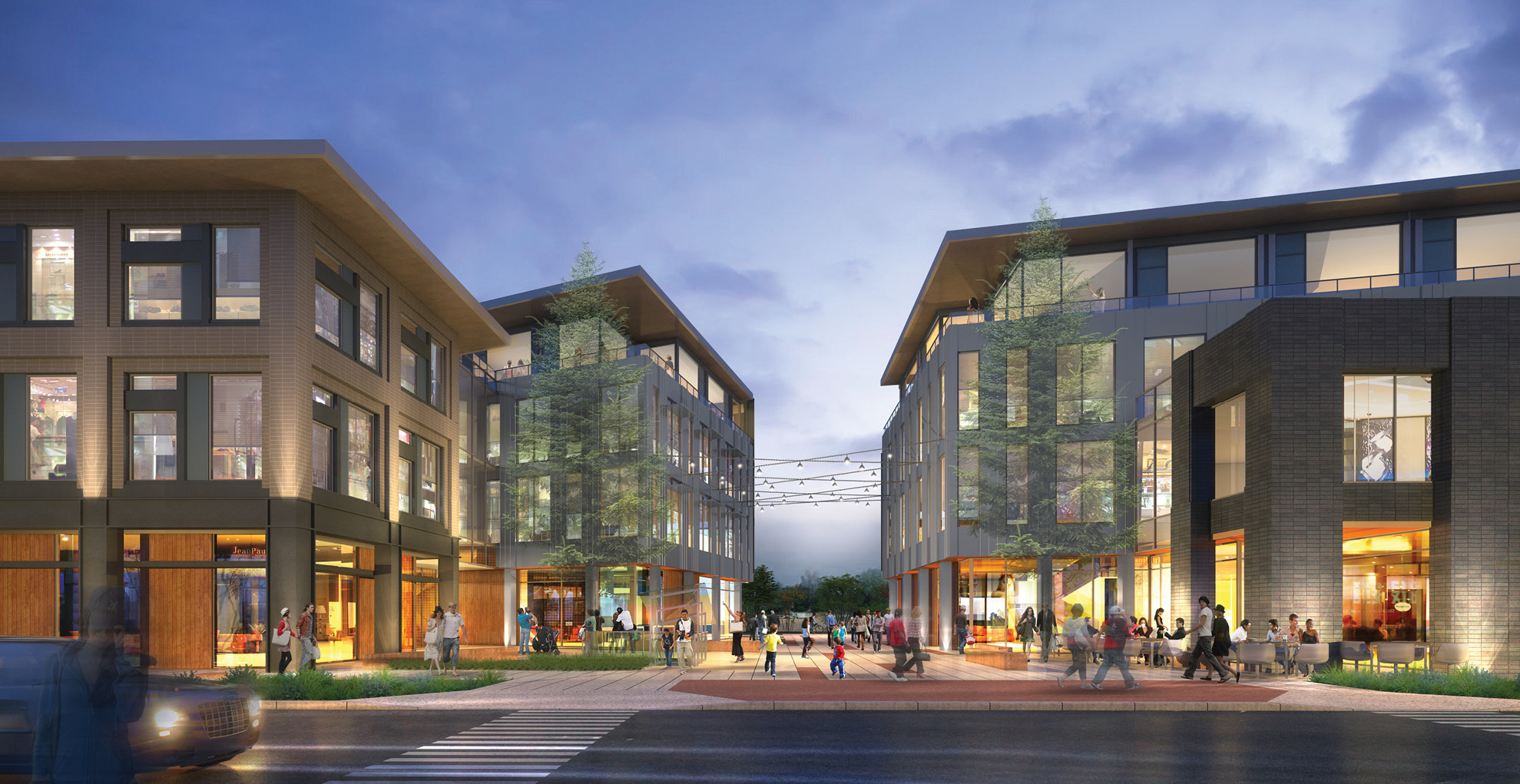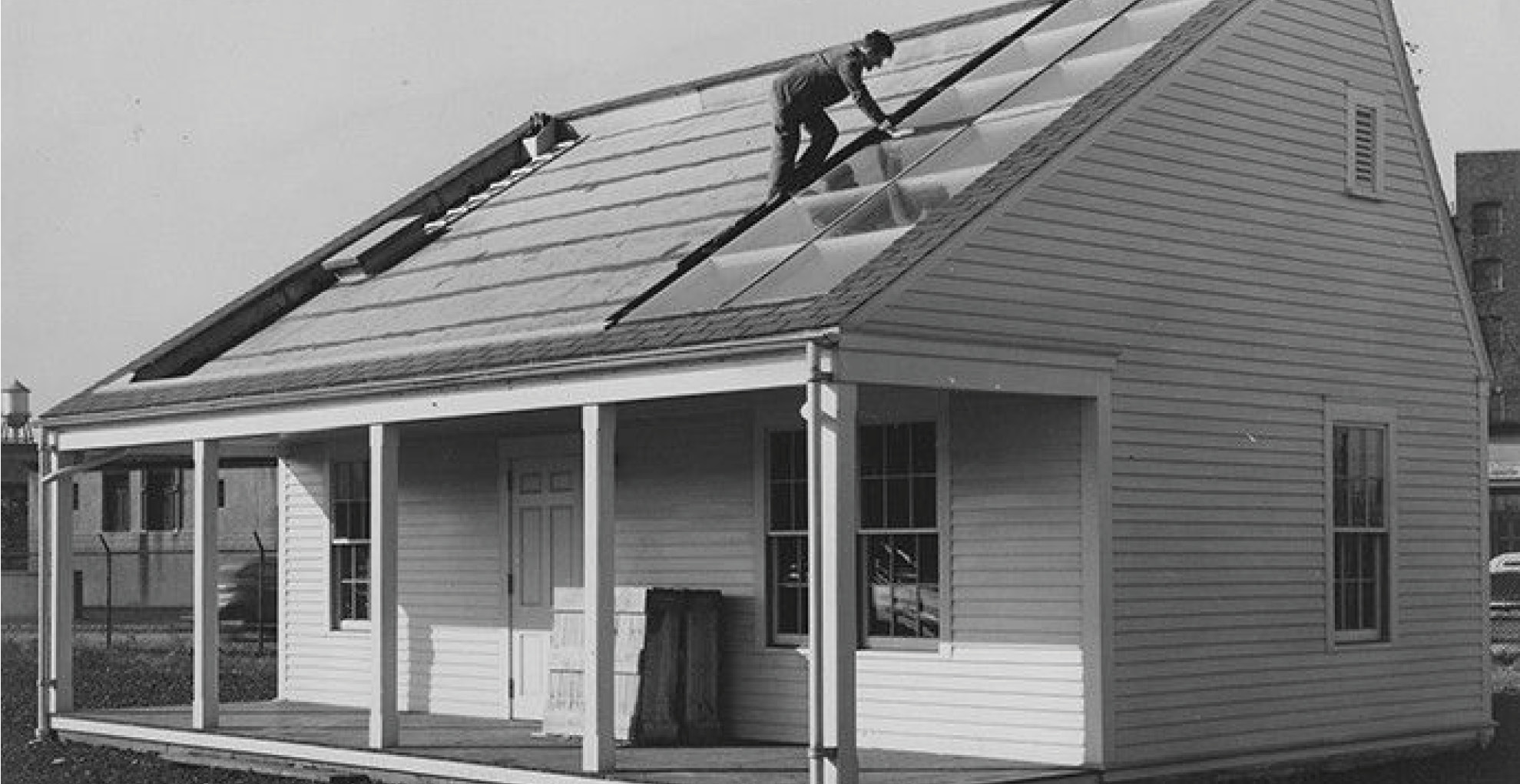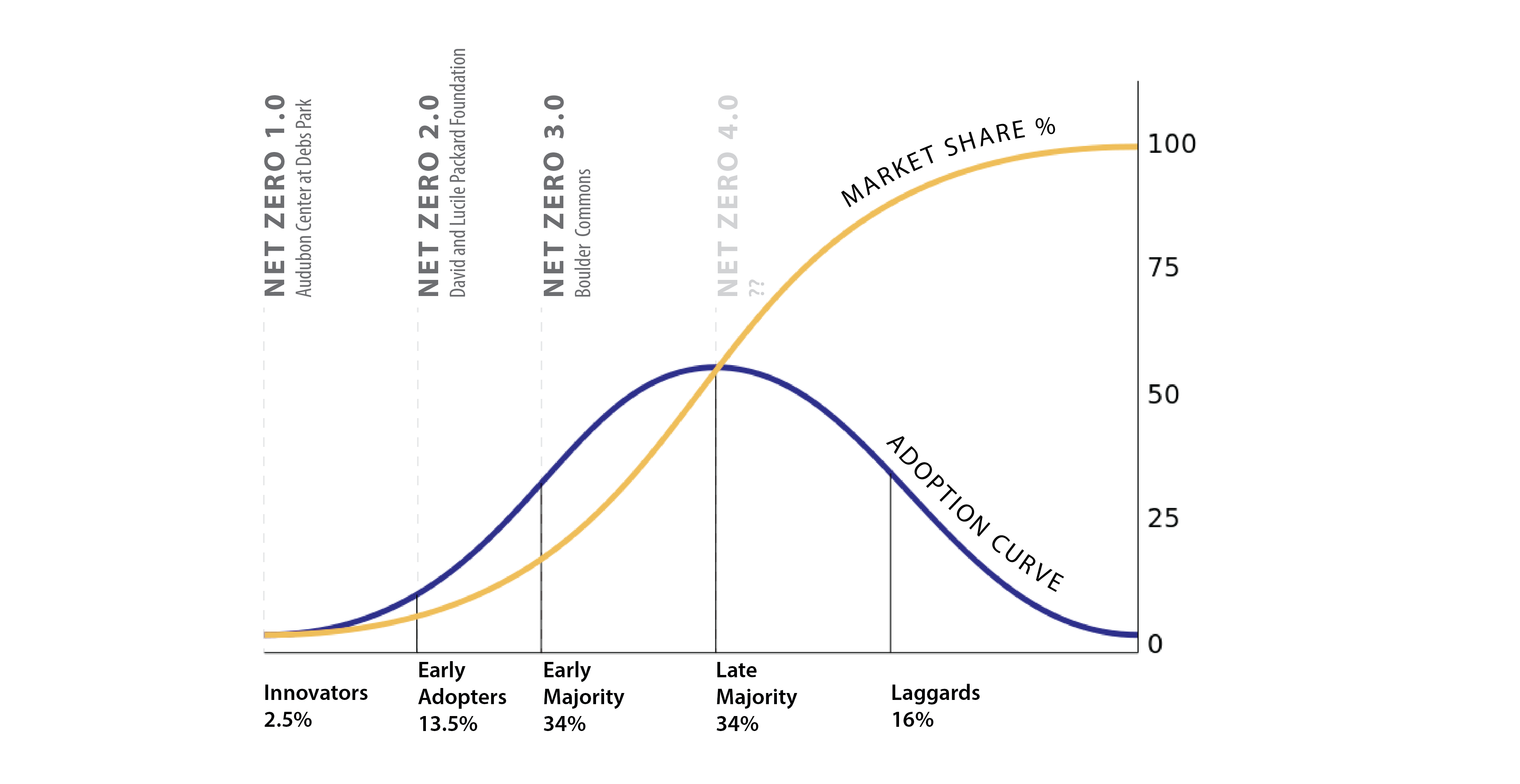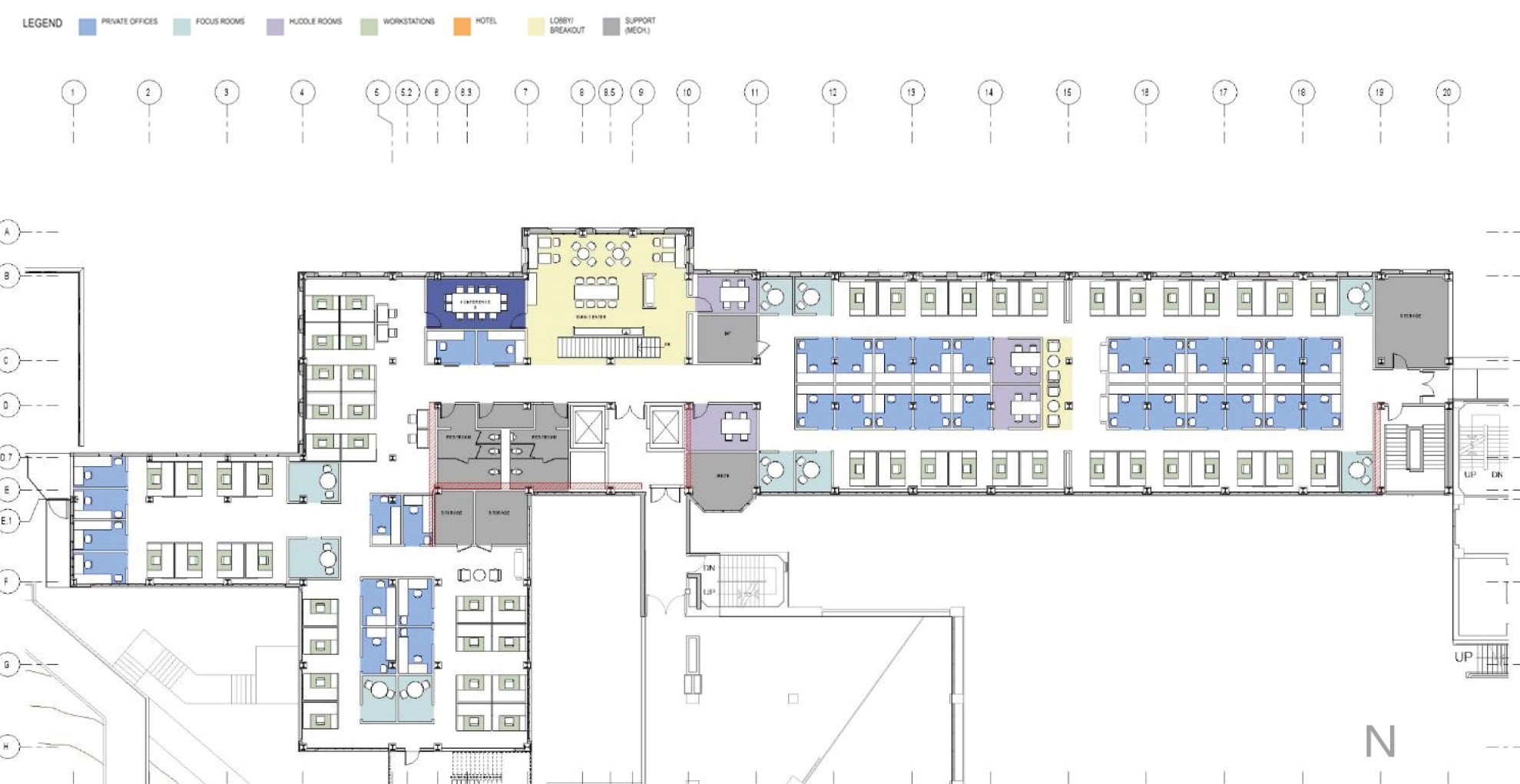Net Zero 3.0
In the classic “diffusion of innovation” diagram, a bell curve describes the path of an innovation from early adoption through market dominance. We all know this path from experience: remember your first friend with a smart phone? Or the first time you saw the Prius? You were intrigued, and perhaps thought them futuristic. Now you can’t imagine your world without them.
We just entered the year 2016. In signing the COP21 treaty, 195 nations agreed to limit greenhouse gas emissions levels to aim to keep global temperature rise under 2°C. Now for the harder part: how? According to the best climate science, programs such as Architecture 2030, and strategic plans of the state of California and others, all new buildings need to be designed to net zero energy (NZE) standards by year 2030 in order for us to avoid the worst impacts of climate change. So where are we today, less than 15 years from 2030, on the NZE “diffusion of innovation” path?
First, let’s quickly put today’s efforts in historical context. As far back as 1939, with the MIT Solar House #1 project, architects and engineers have been experimenting with homes powered by photovoltaics. In the late 20th century these experiments took off in the US Southwest, Japan and Germany in particular. Let’s call this era Net Zero 1.0. The “innovators” responsible for these projects were answering the question, “What if?” EHDD’s first foray into NZE design began in 2001 with the Audubon Center at Debs Park. This nature center in Los Angeles uses a battery array and an improvised load shedding strategy to function without a grid connection.
Further experimentation in non-residential projects such as Chartwell School (2005) led us to design the first NZE office building in the country for David Kaneda’s IDeAs electrical engineering office in 2007. This in turn gave us the confidence to propose a net zero design for the David & Lucile Packard Foundation headquarters. In 2013, this 50,000 SF building operated for its first year at net positive energy, and was certified as the largest NZE building in the country by the International Living Futures Institute. This period, Net Zero 2.0, was driven by “early adopters” who were demonstrating proof-of-concept. At Packard, our goal was “replicability”, which we defined as identifying strategies that could transform the building industry within the next decade. Financial viability was important but there was an understanding that innovation is not easy.
Today we are at an inflection point where innovation reaches critical mass. This is Net Zero 3.0. The “early majority” are leveraging a happy confluence of factors that make NZE good business. Some of these enabling factors include:
Low Photovoltaic (PV) Prices: In 2008, the estimated PV cost for a +300 kw system at our Packard NZE project was at $8.50/watt. This past year we received three bids for a Power Purchase Agreement (PPA) for a similar sized PV array at a private school in Marin County at $3/watt. This PPA will cost 20%-38% LESS than PG&E with no upfront capital cost. It saves money from day one. The upshot: If you have the space to put the PVs, a zero energy building can be cheaper than a conventional building powered solely by the utility company.
Energy Codes are raising the baseline: California’s latest Title 24 energy code requires many of the energy efficiency measures that were considered unusual in Net Zero 2.0 buildings. External insulation, air-tightness requirements, LED lighting, and spectrally-selective low-e glass are among the measures now standard in new buildings in California and many other states. The upshot: The incremental cost to exceed code-mandated efficiency in many states is minimal.
LED lighting is finally here: LED lighting is no longer just beyond the horizon. The technology has matured to provide excellent color, ease of control and dimming, and good optics. When you consider the life-cycle benefits of low maintenance, combined with reduced energy bills, they are the obvious choice for thoughtful building owners. The upshot: Low lighting energy use is achievable without sacrificing quality or affordability.
Plug Loads are trending down: Plug loads for IT have been falling, driven by the desire for longer battery life on our mobile devices, and a new generation of low power consuming chips. In a mobile world governed by battery performance, efficiency is driven by economics not environmentalism. The upshot: The 10-ton gorilla of “uncontrollable” plug loads may be less of a problem as time goes on.
Commissioning is now common: This signals a recognition that buildings need to be operated properly in order to perform properly. The required NZE upgrade to ongoing energy monitoring and diagnostics is the logical next step. The upshot: Owners are engaged in ensuring proper operation so that buildings can achieve the design performance goals.
So what does Net Zero 3.0 look like? One of our projects nearing start of construction is instructive: a 100,000 SF speculative NZE office building in Boulder, CO. The client, a mission-focused investment company, intends to own and operate this building at NZE for the long term, thereby offering a new model of speculative mixed-use infill development that yields triple-bottom line returns. The design process is an interplay between the cost budget, the renewable energy potential of building surfaces, and the resultant energy budget that we have to work with to get to NZE. Our target Energy Use Intensity (EUI) of 28 kBTU/sf is calibrated to the available PV area on the roof and on the southeast-facing façade. Integrating vertically-oriented PVs into that façade promises to be an economically-rational approach since we can subtract out the cost of the avoided cladding material to offset the reduced production efficiency associated with the vertical application. The overall leasing and marketing strategy is geared to take full economic advantage of the life-cycle benefits; for example, tenants will adopt plug load budgets in their lease agreements. Therefore, the overall pro-forma requires a holistic approach to valuing the asset differently than conventional development. Design, operations, and property management are integrated from the start.
We are just at the start of Net Zero 3.0. Yet recent legislation like California’s SB 350, which authorizes state energy authorities to seek 50% increase in energy efficiency by 2030, and implementation of COP21 will drive us towards Net Zero 4.0. During that phase the “late majority” will make NZE buildings into the new business-as-usual. The real question is no longer, “What if?” or “How exactly?” but “Why?”
Brad Jacobson, AIA LEED® AP BD+C
Associate Principal




